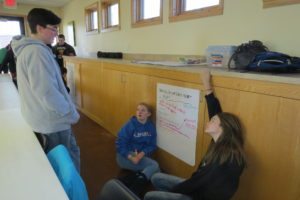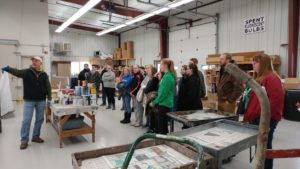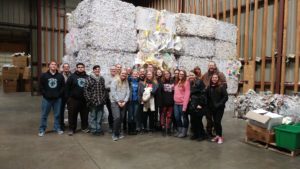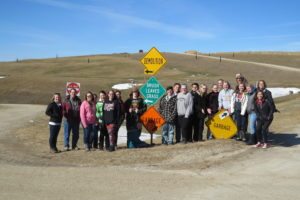Submitted by: Ali Dahmes, West Central YES! Coordinator
On Wednesday, February 15th, 2017, 17 students and their coaches from Atwater-Cosmos-Grove City, Yellow Medicine East, and Alexandria Discovery YES! teams came together at Prairie Woods Environmental Learning Center to expand their knowledge on reducing waste, recycling what can’t be reduced, and the recycling impact on climate change.
The beautiful February day started off with a tour of the Willmar Household Hazardous Waste and Willmar Recycling Facilities. Jay Baker beganby leading the group on a tour of the  Household Hazardous Waste building where he explained what products came into the building, how they were handled, and finally how they were packaged and shipped off to be disposed of properly. He also explained the importance of bringing these materials to the hazardous waste facility so toxins do not end up in our landfills where they become harmful for the environment. Following that tour, Derek Amundson brought the group to the recycling facility where they got to see how recyclables are brought in (already sorted), sorted again by staff, and then fed into a huge machine that bales the like recyclables together. Derek then showed the group the storage facility that houses all the bales until there are enough tons to be shipped off to be processed and used again.
Household Hazardous Waste building where he explained what products came into the building, how they were handled, and finally how they were packaged and shipped off to be disposed of properly. He also explained the importance of bringing these materials to the hazardous waste facility so toxins do not end up in our landfills where they become harmful for the environment. Following that tour, Derek Amundson brought the group to the recycling facility where they got to see how recyclables are brought in (already sorted), sorted again by staff, and then fed into a huge machine that bales the like recyclables together. Derek then showed the group the storage facility that houses all the bales until there are enough tons to be shipped off to be processed and used again.
The group then traveled to Prairie Woods ELC where they first heard from Matt Domski, the Organics Waste Specialist at Minnesota Technical Assistance Program (MnTAP) who focused on encouraging workshop participants to prevent waste at the source. He explained that 20% of the food Americans buy is never eaten; we forget about it, throw out the leftovers, and many times, discard it too soon due to expiration dates on products that are not even created by a mandated procedure. Matt stressed the importance of looking at the whole life-cycle of a product before purchasing it to prevent such waste.
Jenna Totz from Climate Generation then spoke about how recycling is one of the many ways to help mitigate climate change. She started off with a few frightening statistics like how we throw away 4  million plastic bottles in the garbage each hour and that Hersey Kisses wrappers are recyclable but they are so tiny that no one thinks to recycle them! She than explained how when you recycle, all the energy and water put into production cost of producing a new product is cut out of the equations. Not only the energy and water of production but also the transportation emissions from producing new products. Jenna ended with having the students walk around in groups and answer questions about how recycling such as why do people not do it, what could be done to increase recycling habits, what could be done at their schools, and much more.
million plastic bottles in the garbage each hour and that Hersey Kisses wrappers are recyclable but they are so tiny that no one thinks to recycle them! She than explained how when you recycle, all the energy and water put into production cost of producing a new product is cut out of the equations. Not only the energy and water of production but also the transportation emissions from producing new products. Jenna ended with having the students walk around in groups and answer questions about how recycling such as why do people not do it, what could be done to increase recycling habits, what could be done at their schools, and much more.
After traveling one more time, the workshop ended with a tour of the Kandiyohi County Solid Waste  Sanitary Landfill. Participants got some fresh air driving to the top of the second highest point in Kandiyohi County, the top of a ~100 foot deep garbage pile. Jeff Bredberg spoke to the participants about the history of the landfill and how Minnesota has laws in place that prohibit any production of new landfills, therefore we must conserve the space that is left in the existing landfills (by recycling and composting). The group then toured the weigh station and learned about the only existing state of the art leachate treatment system in the United States. He explained that in the past, and in other landfills, the water that permeates through the garbage after rain and snowfall was collected and brought to the waste water treatment plant where the water was treated so it could be returned to the environment. The system put in place in 2015 treats the leachate on site, therefore cutting out transportation cost and emissions. Although it may be gross, the black oil looking leachate is so clean after it is treated in this system that you could drink it! The day ended by looking at two containers, one filled with leachate before it was treated, and one after.
Sanitary Landfill. Participants got some fresh air driving to the top of the second highest point in Kandiyohi County, the top of a ~100 foot deep garbage pile. Jeff Bredberg spoke to the participants about the history of the landfill and how Minnesota has laws in place that prohibit any production of new landfills, therefore we must conserve the space that is left in the existing landfills (by recycling and composting). The group then toured the weigh station and learned about the only existing state of the art leachate treatment system in the United States. He explained that in the past, and in other landfills, the water that permeates through the garbage after rain and snowfall was collected and brought to the waste water treatment plant where the water was treated so it could be returned to the environment. The system put in place in 2015 treats the leachate on site, therefore cutting out transportation cost and emissions. Although it may be gross, the black oil looking leachate is so clean after it is treated in this system that you could drink it! The day ended by looking at two containers, one filled with leachate before it was treated, and one after.
“We must do what we conceive to be right and not bother our heads or burden our souls with whether we’ll be successful. Because if we don’t do the right thing, we’ll do the wrong thing and we’ll be part of the disease and not part of the cure.” – E.F. (Fritz) Schumacher